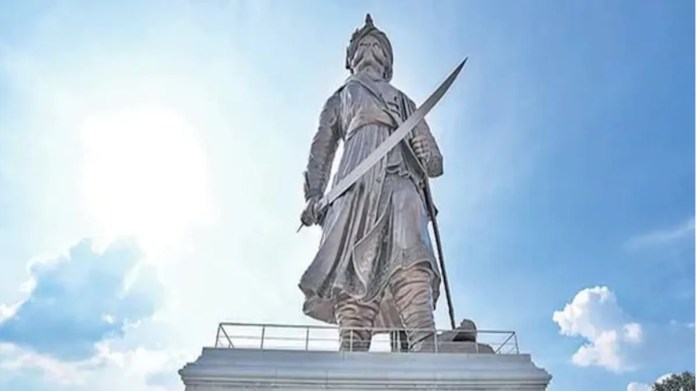Prime Minister Narendra Modi today inaugurated the glitzy Terminal 2 of the Kempegowda International Airport in Bengaluru. Nicknamed “Terminal in a Garden”, this eco-friendly facility has been built largely using bamboo and will cater to 2.5 crore passengers annually. The estimated construction cost for this terminal is around Rs 5,000 crore.
“The T2 is an architectural wonder, which is a first-of-its-kind ‘Terminal in a Garden’. It will have lush greenery within and outside and will be a visual delight like no other in the world. The passengers’ experience is designed to be a walk in the garden while travelling through the new terminal,” a KIA official said.
While how the new facility will help people is all over the media today, many want to know who Kempegowda, after whom the Bengaluru airport is named, was.
Who Kempegowda was
Nadaprabhu Hiriya Kempe Gowda, also known as Kempegowda, was a chieftain under the Vijayanagara Empire. He fortified the city of Bengaluru, the capital of Karnataka, in 1537. He put in place many Kannada inscriptions in the region. Being of Telugu origin, he was also well-versed in the Telugu language. He authored the play called Gangagourivilasam or Ganga Gouri Sallapamu in Telugu.
Kempegowda was one of the most well-educated and successful rulers of his time. Being a successor of descendants of the Morasu Gowda lineage, which had started as Yelahankanadu Prabhus (ruler of Yelhankanadu). The Yelahankanadu Prabhus belonged to the Gowda community. The fourth in succession from Rana Bhairave Gowda, the founder of the dynasty of Avati Nadu Prabhus and great-grandson of Jaya Gowda, who established a separate dynasty, is the famous Yelahanka Nadu Prabhus, Kempegowda I, who ruled for 46 years commencing his reign from 1513.
Jaya Gowda accepted the sovereignty of the Vijayanagar emperor. He later left Yelankanadu and was successful in planning and building Bengaluru Fort and Bengaluru Pete, the foundation of the current city of Bengaluru. He is noted also for his social reforms and contribution to building temples and water reservoirs in Bengaluru.
Kempegowda’s birth anniversary celebrations are organized by the state government every year across Karnataka from 27 June 2017. It is observed as Kempegowda Day or Kempegowda Jayanthi. An award is established and named after the ruler, called Kempegowda Award, which is presented annually at a ceremony held by BBMP.
Early life of Kempegowda
Hiriya Kempegowda was born in Yelahanka and was the son of Morasu Vokkaliga Kempananje Gowda, who had ruled Yelhankanadu for more than 70 years. The powerful chiefly family claimed to have moved from Kanchi in Tamil Nadu to Karnataka in the early 15th century and served the Vijaynagar Empire.
The family was originally from Karnataka and was a Kannada-speaking community albeit well-versed in Telugu. Kempegowda, who is reputed to have shown leadership skills during his childhood, was educated at Gurukula in Aivarukandapura (Aigondapura), a village near Hesaraghatta, for nine years. Kempegowda assumed the chieftaincy from his father in 1513.
Kempegowda is believed to have received a vision of building a big futuristic city during a hunting expedition when he went towards Shivanasamudra (near Hesaraghatta) from Yelahanka with his Minister Veeranna and Advisor Gidde Gowda. He envisioned the city to have a fort, a cantonment, tanks (water reservoirs), temples and people of all trades and professions to live in it. He conquered the Sivaganga principality, 48 km from Bengaluru on the Bengaluru-Pune highway.
Next, the visionary annexed Domlur, which is on the road from Bengaluru to the old Bengaluru airport. Within this vast forest area, with the necessary Imperial permission of the Vijayanagar Emperor, Achyutharaya (Dasarahalli record dated 1532), he built Bengaluru Fort and the town in AD 1537 and moved his capital from Yelahanka to the new Bengaluru Pete.
Kempegowda builds Bengaluru
Kempegowda built a red fort with eight gates and a moat surrounding it. Inside the fort, two wide roads ran from north to south and east to west. The other roads were made parallel or perpendicular to them. On an astrologically auspicious moment, Kempegowda harnessed the bullocks to the ploughs at the central Doddapete square, at the junction of Doddapete (Avenue Road) and Chikka pete, got the ground ploughed and worked the four main streets running in four directions. One ran from Halasoor (Ulsoor) Gate to Sondekoppa Road from east to west, and another from Yelahanka Gate to the fort running from north to south. These roads are the present Nagarthapete, Chikkapete and Doddapete respectively.
The streets and blocks were demarcated for the purpose they were meant, like for business or residences etc. Streets of Doddapete, Chikkapete and Nagartha-pete were for marketing of general merchandise; Aralepete (Cotton pet), Tharagupete, Akki pete, Ragipete, Balepete etc. were for marketing of commodities like cotton, grain, rice, ragi, and bangles respectively: Kurubarapete, Kumbara-pete, Ganigarapete, Upparapete etc. were for trades and crafts, and residences of Kuruba, Kumbara, Ganiga, Uppara castes respectively and similar petes’ (blocks). Halasoorpete, Manavarthe-pete, Mutyalapete (Ballapurapete) etc. were meant for other groups of society.
The agraharas were for the priests and learned classes. He got skilled artisans and craftsmen from the neighbouring as well as far-off places and got them settled so that they could pursue their vocations.
Temples of Vinayaka (Ganesha) and Anjaneya )Hanuman) were built at the Northern Yelahanka Gate of the fort (near the present head office of State Bank of Mysore). Dodda Basavannanagudi (The Bull Temple) and in its neighbourhood, Dodda Vinayaka and Dodda Anjaneya and Veerabhadhra temples were also built outside the fort on the southern side. Gavi Gangadhareshwara temple was also built by Kempegowda. Kempegowda I encouraged the construction of temples and lakes and planned residential layouts, or agraharas, around each temple. The construction of the mud fort and several temples and lakes transformed Bengaluru from a sleepy village to a centre of culture based on Vedic traditions.
Tanks were built for the water supply to the town, to the moat around the fort and for the irrigation of crops. Inside the fort, a big pond enclosed by the masonry of dressed granite stones was dug and built (on the South-Western corner of the present Sri Krishnarajendra Market). Dhar-mambudhi tank, which supplied water to the town (present Subhash Nagar, BMTC bus stand and KSRTC bus stand, in front of the city Railway Station), Kempambudhi tank (named after Ranabhaire Gowda’s family Goddess, Doddamma or Kempamma), in Gavipura Guttahalli and Sampigambudhi tank (named after one of the daughters-in-law: present Sree Kanteerava Stadium), which were meant for irrigation, were also built. Irrigational facilities gave much impetus to agriculture and horticulture and also encouraged the laying of gardens and raising groves of fruit crops.
The Emperor of Vijayanagara pleased with his activities bestowed him with nearby villages of Halasooru (Ulsoor), Begur, Varthur, Jigani, Thalagattapura, Kumbalgodu, Kengeri and Banavara.
Social reforms, patronage for art
One of his social reforms was to prohibit the custom of amputating the last two fingers of the left hand of unmarried women during “Bandi Devaru”, an important custom of Morasu Vokkaligas. He was a patron of art and learning. Despite belonging to a purely Kannada-speaking community, he was multilingual and authored Gangagaurivilasa, a yakshagana play in Telugu, the court language of the time.
In the mid-16th century due to a complaint from neighbouring Palegar, Jagadevaraya of Channapattanathe, Emperor Sadashivaraya of Vijayaror’s prior approval and for fear of rising in power at Penukonda. His territories were also confiscated. He was later released after being imprisoned for five years. After being released, he was awarded back his territories.
Legacy
He died in 1569, having ruled for about 56 years. A metal statue of Kempegowda was posthumously installed in 1609 at the Gangadhareshwara temple at Shivagange. In 1964, another statue was erected in front of the Corporation Office, Bengaluru. According to some literary sources, Bengaluru Kempegowda’s elder son Gidde Gowda took over control after his death.
On 14 December 2013, Bengaluru’s main international airport was renamed Kempegowda International Airport.
Bengaluru’s prominent Kempegowda Bus Station has been named so to honour Kempegowda. The Bengaluru Development Authority developed the Nadaprabhu Kempegowda Layout. The prominent Majestic metro station on the Purple Line (Namma Metro) of Bengaluru’s Namma Metro has been renamed in Kempegowda’s honour.
Educational institutions such as the Kempegowda Institute of Medical Sciences, Kempegowda Institute of Physiotherapy, Kempegowda College of Nursing, and the Kempegowda Residential PU College have been named after Kempegowda. A locality and a park in Bengaluru are named in Kempegowda’s honour. A busy thoroughfare in Bengaluru has been named the Kempegowda Road. The Nadaprabhu Kempegowda Convention Center is located in Bengaluru.
On 27 June 2020 commemorating the 511th birth anniversary of Kempegowda, work on a 108-feet tall Kempegowda Statue and a 23-acre Central park around the statue formally began with Chief Minister BS Yediyurappa performing a Bhoomi Pooja at the Kempegowda International Airport. The same was inaugurated by PM Narendra Modi on 11th Nov 2022.
Lineage
The lineage of Kempegowda lasted for a century in Magadi, where they built many temples, forts and tanks. Nelapattana, a subterranean town was built on the foot of the Savandurga, to protect themselves from foreign invasions. However, in 1728, the Dalawayis of the Mysore Kingdom defeated Kempegowda and annexed the principality. The last ruler was imprisoned in Srirangapatana till his death. The family members were moved to Hulikal village in Magadi, where the lineage continues to survive. Some other family members were pensioned off by Dewan Purnaiah by granting jagirs in Hosur, present-day Tamil Nadu, where the lineage continues to exist as farmers.
Mortal remains
The inscription of the 16th century in Kannada on the tomb proclaims that Hiriya Kempegowda had died at the spot while returning from Kunigal. Reportedly after settling a dispute, Kempagowda was returning to Bengaluru from Kunigal. On 7 March 2015 the tomb was accidentally found by Prashanth Marur, a college official turned historian while he was driving by Kempapura village in Magadi. It was also authenticated by a group of historians who visited the tomb. It is believed that Immadi Kempegowda, son of Kempegowda I, built the tomb when his father died. After the confirmation, Prashanth Marur wrote an article and published it in Vijayavani newspaper on 3 September 2015.




You must log in to post a comment.